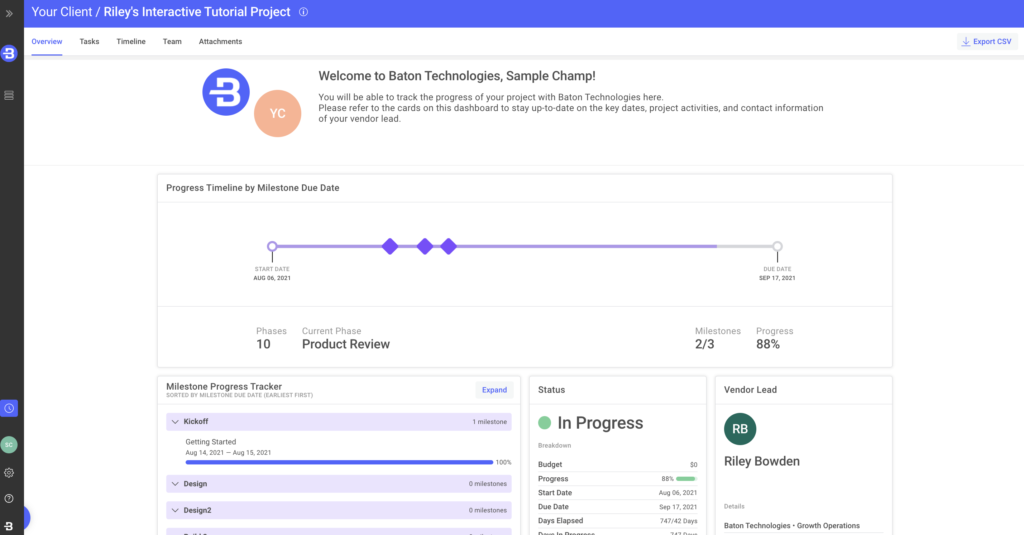What Is Customer Onboarding?
Customer onboarding is a pivotal process in that sets the tone for long-lasting business relationships. This crucial stage involves welcoming new customers into a company’s ecosystem and guiding them through the initial steps of their journey. It encompasses various activities, from account setup to product familiarization, ensuring customers have a positive first experience.
Why Is Customer Onboarding Important?
At the start of the customer journey, customer onboarding holds paramount significance for software companies. It serves as the initial point of contact between a customer and the software product or service, leaving a lasting impression. A smooth, well-structured onboarding process can enhance user satisfaction, instill confidence, and minimize early frustrations, increasing the likelihood of customer retention.
Secondly, effective onboarding accelerates time-to-value. It helps users swiftly grasp the software’s functionality, enabling them to realize its benefits more rapidly. This rapid ROI is a critical factor in customer satisfaction and can lead to positive word-of-mouth referrals, which can be a valuable source of new business.
A positive customer onboarding experience ultimately aids in reducing churn. When users face difficulties during the initial stages of their interaction with the software, they may become disenchanted, seek alternatives, and ultimately churn. A comprehensive onboarding process can proactively address these issues, lowering the chances of customers abandoning the software in frustration.
In today’s highly competitive software market, where users have a plethora of choices, a stellar onboarding process can be the differentiating factor that makes customers choose and stick with a particular product. Consequently, software companies that prioritize and invest in customer onboarding are better positioned to thrive and build enduring customer relationships.
Key Components of Customer Onboarding
A successful software customer onboarding process is a well-structured and strategic approach that sets the stage for a positive customer experience. It helps clients effectively adopt and integrate the software into their workflows while achieving their desired outcomes. Here are the key components of a successful software customer onboarding process:
1. Clear Communication and Expectation Setting:
Establish clear lines of communication with the customer from the very beginning. Set realistic expectations regarding what the software can and cannot do, project timelines, and responsibilities. Transparency is crucial to building trust.
2. Customized Onboarding Plan:
Develop a tailored onboarding plan that aligns with the customer’s unique needs, goals, and workflows. Avoid one-size-fits-all approaches and adapt the plan based on the customer’s industry, size, and specific use cases.
3. Dedicated Onboarding and Customer Success Manager:
Assign a dedicated project manager to act as the primary point of contact between the software company and the customer. This person should advocate for the customer and ensure their needs are met.
4. Effective Training and Education:
Provide comprehensive training resources, including documentation, video tutorials, webinars, and one-on-one training sessions. Ensure that users have the knowledge and skills to use the software effectively.
5. Technical Support and Troubleshooting:
Offer timely and accessible technical support to assist customers with any issues or questions they may have during the onboarding process. A responsive support team can prevent frustrations and setbacks.
6. Configuration and Customization:
Customize the software to align with the customer’s specific requirements. This may involve adjusting settings, adding custom features, or integrating with other tools used by the customer.
7. Data Migration and Integration:
If necessary, assist the customer with migrating data from legacy systems and ensure seamless integration with other applications. Data migration should be error-free and well-documented.
8. Progress Tracking and Milestones:
Establish clear milestones and key performance indicators (KPIs) to track the customer’s progress during onboarding. Regularly review these metrics to ensure the customer is on the right path.
9. Reporting, Documentation, and Resources:
Maintain a comprehensive knowledge base and documentation library that customers can access for self-service troubleshooting and guidance. Keep these resources up-to-date. In addition, historical data and analytics should be used to measure not only the customer’s success with the software but also the effectiveness of your onboarding process as a whole. This may include tracking metrics like time-to-launch, user adoption rates, task completion times, and return on investment (ROI).
10. Post-Implementation Support:
Offer ongoing support after the initial onboarding phase is complete. Continue to address customer questions, provide assistance with advanced features, and ensure that the software remains aligned with evolving needs.
Crush Every Customer Onboarding Project
Looking to step up your team’s implementation and onboarding game?
Regardless of size, your implementation and onboarding teams can benefit from the strategic wisdom in this guide to drive real, measurable results.
Who’s Involved in the Customer Onboarding Process?
Successful customer onboarding in any software company relies on the collaboration and expertise of various stakeholders. Each stakeholder has a unique role to play in ensuring that the customer’s journey from initial contact to full adoption goes smoothly and successfully crosses the finish line. By recognizing the importance of these stakeholders and fostering effective communication and cooperation among them, software companies can create a positive onboarding experience that sets the stage for long-term customer success.
1. C-Suite Executives:
At the helm of any customer onboarding project are C-suite executives, including the Chief Executive Officer (CEO), Chief Information Officer (CIO), and Chief Financial Officer (CFO). These leaders are often responsible for green lighting the project, aligning it with the company’s strategic goals, and allocating the necessary budget and resources. Their endorsement of the project ensures that it receives the attention and backing it requires to succeed.
2. Implementation & Onboarding Project Managers:
A skilled and specialized customer onboarding project manager acts as the glue that holds the various aspects of an onboarding project together. This individual is responsible for creating a comprehensive project plan, setting milestones, allocating resources, and ensuring that the project stays on track and within the defined timelines. The project manager also serves as a communication bridge between different stakeholders, keeping everyone informed about the project’s progress and any potential roadblocks.
3. Sales and Revenue Teams:
The sales team is often the first point of contact with prospective customers. They play a pivotal role in understanding their needs and expectations – setting the tone for all future communications. During the onboarding process, the sales team is responsible for ensuring that the customer’s expectations align with what the software can deliver. Their input is crucial in setting realistic goals and defining the scope of the project.
4. Customer Success Team:
The customer success team is dedicated to ensuring that customers achieve their desired outcomes with the software. They are responsible for developing an onboarding plan tailored to each customer’s needs. This plan includes training sessions, resources, and support channels. Customer success managers act as advocates for the customer within the software company and play a vital role in maintaining ongoing relationships.
5. Professional Services Team:
Often responsible for the technical delivery of a solution, professional services teams play a pivotal role in customer onboarding project. These teams are often comprised of technical experts who have deep knowledge of the software product and its various components. Their primary goal is to ensure a smooth and successful transition for the customer as they adopt and integrate the software into their operations..
6. Legal Teams:
The legal team plays an important role in drafting and reviewing contracts and agreements between the software company and its customers. They ensure that the terms and conditions are clear, fair, and legally binding. Legal expertise is especially crucial when dealing with large enterprise clients or government organizations.
7. External Consultants:
In some cases, organizations may opt to engage external consultants or advisors who specialize in implementation and customer onboarding. These experts bring industry insights, best practices, and a wealth of experience to the table. Their objective perspective can help identify blind spots, offer strategic guidance, and optimize the implementation and onboarding process.
8. End Customers:
Last, but certainly not least, end customers are the individuals who will directly interact with the software solution on a day-to-day basis. Their needs, preferences, and feedback are essential in shaping the selection and customization of the solution. Involving end users from the early stages of the project helps identify specific requirements and potential challenges, ensuring that the implemented solution aligns with their workflows and enhances their productivity.
Key Factors to Include When Building Your Customer Onboarding Process
Customer onboarding is a critical juncture in the relationship between a software company and its clients. It’s the stage where first impressions are formed, expectations are set, and the foundation for a long and fruitful partnership is laid. To ensure that this phase unfolds seamlessly and sets the stage for a successful customer journey, it’s imperative to incorporate key components into the onboarding process.
1. Real-Time Transparency for All Project Stakeholders
Visibility and transparency are crucial to ensuring all project stakeholders remain on the same page throughout the course of the project and things run smoothly. This means the entire project team, from executives, individual contributors, and the client, is involved and engaged in the project.
Unfortunately, many static tools like spreadsheets don’t offer a level of visibility that works for complex and high volume projects. What ends up happening is information and data is stored in silos and transferred via email. Too many breakage points exist in the “old” way of running customer onboarding projects.
On the opposite side of things, teams who adopt a purpose-built customer onboarding solution have a living and breathing system of record. This gives the entire project team a live look at where things stand, what tasks are assigned to them, and allows project managers to quickly identify bottlenecks.
Transparency is also paramount for improving the next key component: customer engagement.
2. Customer Engagement
Customer onboarding projects are collaborative by nature. After all, without a client, there would be no client onboarding. There are likely a host of different tasks assigned to your client during the process. Getting the client to complete those tasks is the only way to ensure successful adoption.
Tasks range from document collection to integration work. When customers first switch to customer onboarding software like Baton, customer engagement is almost always the immediate biggest difference. This has to do with an increased level of visibility and automation.
With Baton, things like document collection are handled by native forms that automatically capture customer data and feed it directly into the project. Baton also eliminates updates by email. Customers are automatically keyed in on every detail through automated alerts and a real-time client portal.
3. Established Processes and Automated Workflows
The odds are you are running multiple client onboarding projects concurrently. As project count grows, so does the administrative work. If you are using static tools like spreadsheets and emails, every new project will start with a new sheet, someone on the team will be assigned the task of setting that sheet up, and the cycle continues until the team is buried.
With a standardized workflow, implementation and onboarding teams are able to templatize their process which cuts down on project admin time and ensures a consistent experience across your entire portfolio. Consistency is key as you continue to scale your business and team.
Static tools also lack automation. So even if you are starting from a template, project administration and dual entry will still exist in your process.
The ultimate goal of any customer onboarding process is to get customers successfully to go-live as quickly as possible. By eliminating dual entry and automating project administration, your team will be able to focus on driving solutions for the client.

Top Benefits of Adopting a Purpose-Built Customer Onboarding Solution
Your implementation and onboarding experience can make or break any new customer relationship. Because the stage is often viewed as the most critical phase of the customer journey, it’s imperative that you adopt the right solution to ensure your team manages each phase and task efficiently and correctly to ensure every project runs smoothly and your new customer relationship gets off on the right foot.
Join us as we explore how purpose-built technology solutions can revolutionize your implementation and customer onboarding processes, making your software company a force to be reckoned with in the industry.

1. Quality control! You’ll establish efficient and repeatable implementation processes.
Utilizing a purpose-built SaaS implementation management solution will allow you to ensure every implementation project successfully crosses the finish line. With automated workflows and reusable project templates, you’ll accelerate time-to-value, improve engagement, and ultimately ensure a positive customer experience.

2. Increased transparency. Seamless collaboration and real-time visibility for everyone.
By giving key stakeholders real-time visibility into project status and providing a centralized hub to complete tasks and share important project information, an implementation-specific project management solution will help your organization avoid roadblocks and improve both collaboration and accountability.

3. A single source of truth! Avoid data silos and centralize key project information.
SaaS implementation platforms act as a centralized system of record for internal teams and external clients. Managing all of your projects in a single location will allow your team to leverage project trends and audit trails to streamline project handoffs and identify opportunities for process improvements.

4. Project automation. Eliminate duplicative data entry by automating tasks, alerts, and approvals.
Utilizing a SaaS implementation management solution that can automate communications and integrate with your team’s existing tech stack will help cut down on tedious back-and-forth communication. Eliminate duplicative tasks and avoid additional inbox clutter by adopting a platform with automated communication, reminders, and alerts.
Is an onboarding solution right for you?
From mid-market SaaS to at-scale unicorns, the industry leaders have utilized Baton to add efficiency and improve their customer onboarding experience.
How These 3 Companies Utilize Customer Onboarding Solutions

Built Technologies
Committed to adding new levels of efficiency to the construction finance industry, Built leverages Baton’s implementation solution to streamline processes and heighten client engagement during onboarding.
Since adoption, Baton has helped Built’s team move away from overly complex project management tools and embrace a more agile client onboarding experience that has been well received by clients.
"When looking for a tool to support Built’s Implementation team it was important to find something that not only works for Built but also for our clients. In addition, we wanted a way to have transparency to all implementation projects in flight. Baton provides this and so much more."
Joseph Moon, Implementation Manager, Built Tweet

Sight Machine
Manufacturing data platform, Sight Machine, choose Baton’s implementation management solution to create a standardized implementation & onboarding structure.
Since using Baton, Sight Machine has been able to create reusable project templates that can be easily tailored to unique customer needs.
“When I’ve inherited another manager’s project, it’s helpful to view a history of what’s been completed and understand the current state of the project in Baton. It’s a nice checklist to go through when transitioning active projects over.”
May Son, Customer Engagement Manager, Sight Machine Tweet

LoadStop
Relatively new to managing software implementations, Alexander Paris, LoadStop’s Project Manager of Client Services, was in search of a simple and easy-to-use tool that could help systematize and enhance their customer experience from end to end.
After researching several solutions, Alex and the LoadStop team found the “perfect fit” with Baton.
An easy to use solution that was simple and streamlined enough to complement a small, early-stage company, yet flexible and technically powerful enough to support LoadStop through the coming stages of growth and scale.
Since implementing the Baton, LoadStop has cut implementation times from an average 2 months to 4 weeks AND reduced customer onboarding-related churn to <1%.
Fast Track Your Customer Onboarding Process
Baton believes that the value of any software rests within the user experience, and that its lifetime value can far exceed its cost, when thoughtfully and properly onboarded. Wherever your starting point, Baton can take your customer onboarding process to the next level.



